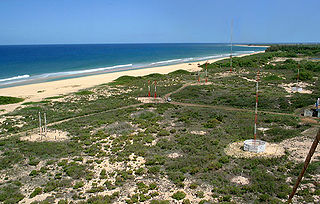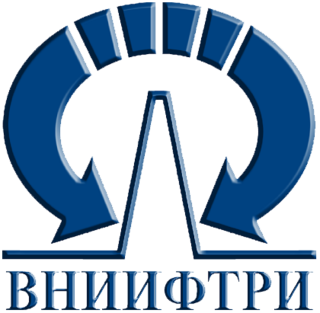
Very low frequency or VLF is the ITU designation for radio frequencies (RF) in the range of 3–30 kHz, corresponding to wavelengths from 100 to 10 km, respectively. The band is also known as the myriameter band or myriameter wave as the wavelengths range from one to ten myriameters. Due to its limited bandwidth, audio (voice) transmission is highly impractical in this band, and therefore only low data rate coded signals are used. The VLF band is used for a few radio navigation services, government time radio stations and for secure military communication. Since VLF waves can penetrate at least 40 meters (131 ft) into saltwater, they are used for military communication with submarines.
Low frequency (LF) is the ITU designation for radio frequencies (RF) in the range of 30–300 kHz. Since its wavelengths range from 10–1 km, respectively, it is also known as the kilometre band or kilometre wave.

A radio clock or radio-controlled clock (RCC), and often colloquially referred to as an "atomic clock", is a type of quartz clock or watch that is automatically synchronized to a time code transmitted by a radio transmitter connected to a time standard such as an atomic clock. Such a clock may be synchronized to the time sent by a single transmitter, such as many national or regional time transmitters, or may use the multiple transmitters used by satellite navigation systems such as Global Positioning System. Such systems may be used to automatically set clocks or for any purpose where accurate time is needed. Radio clocks may include any feature available for a clock, such as alarm function, display of ambient temperature and humidity, broadcast radio reception, etc.

In radio, longwave, long wave or long-wave, and commonly abbreviated LW, refers to parts of the radio spectrum with wavelengths longer than what was originally called the medium-wave broadcasting band. The term is historic, dating from the early 20th century, when the radio spectrum was considered to consist of longwave (LW), medium-wave (MW), and short-wave (SW) radio bands. Most modern radio systems and devices use wavelengths which would then have been considered 'ultra-short'.
The Time from NPL is a radio signal broadcast from the Anthorn Radio Station near Anthorn, Cumbria, which serves as the United Kingdom's national time reference. The time signal is derived from three atomic clocks installed at the transmitter site, and is based on time standards maintained by the UK's National Physical Laboratory (NPL) in Teddington. The service is provided by Babcock International, under contract to the NPL. It was funded by the former Department for Business, Innovation and Skills; as of 2017 NPL Management Limited (NPLML) was owned by the Department for Business, Energy and Industrial Strategy (BEIS), and NPL operated as a public corporation.
CHU is the call sign of a shortwave time signal radio station operated by the Institute for National Measurement Standards of the National Research Council. CHU's signal is used for continuous dissemination of official Canadian government time signals, derived from atomic clocks.

WWV is a shortwave radio station, located near Fort Collins, Colorado. It has broadcast a continuous time signal since 1945, and implements United States government frequency standards, with transmitters operating on 2.5, 5, 10, 15, and 20 MHz. WWV is operated by the U.S. National Institute of Standards and Technology (NIST), under the oversight of its Time and Frequency Division, which is part of NIST's Physical Measurement Laboratory based in Gaithersburg, Maryland.

WWVH is the callsign of the U.S. National Institute of Standards and Technology's shortwave radio time signal station located at the Barking Sands Missile Range, in Kekaha, on the island of Kauai in the state of Hawaii.
WWVB is a time signal radio station near Fort Collins, Colorado and is operated by the National Institute of Standards and Technology (NIST). Most radio-controlled clocks in North America use WWVB's transmissions to set the correct time. The 70 kW ERP signal transmitted from WWVB is a continuous 60 kHz carrier wave, the frequency of which is derived from a set of atomic clocks located at the transmitter site, yielding a frequency uncertainty of less than 1 part in 1012. A one-bit-per-second time code, which is based on the IRIG "H" time code format and derived from the same set of atomic clocks, is then modulated onto the carrier wave using pulse-width modulation and amplitude-shift keying. A single complete frame of time code begins at the start of each minute, lasts one minute, and conveys the year, day of year, hour, minute, and other information as of the beginning of the minute.
RWM is the callsign of a high frequency (shortwave) standard frequency and time signal radio station in Moscow, Russia. It is controlled by All-Russian Scientific Research Institute for Physical-Engineering and Radiotechnical Metrology, and operated by Russian Television and Radio Broadcasting Network. Transmitting frequencies are 4.996 MHz with 5 kW and on 9.996 and 14.996 MHz with 8 kW.
JJY is the call sign of a low frequency time signal radio station located in Japan.

DCF77 is a German longwave time signal and standard-frequency radio station. It started service as a standard-frequency station on 1 January 1959. In June 1973 date and time information was added. Its primary and backup transmitter are located at 50°0′56″N9°00′39″E in Mainflingen, about 25 km south-east of Frankfurt am Main, Germany. The transmitter generates a nominal power of 50 kW, of which about 30 to 35 kW can be radiated via a T-antenna.
Communication with submarines is a field within military communications that presents technical challenges and requires specialized technology. Because radio waves do not travel well through good electrical conductors like salt water, submerged submarines are cut off from radio communication with their command authorities at ordinary radio frequencies. Submarines can surface and raise an antenna above the sea level, or float a tethered buoy carrying an antenna, then use ordinary radio transmissions; however, this makes them vulnerable to detection by anti-submarine warfare forces.

Grimeton Radio Station in southern Sweden, close to Varberg in Halland, is an early longwave transatlantic wireless telegraphy station built in 1922–1924, that has been preserved as a historical site. From the 1920s through the 1940s it was used to transmit telegram traffic by Morse code to North America and other countries, and during World War II was Sweden's only telecommunication link with the rest of the world. It is the only remaining example of an early pre-electronic radio transmitter technology called an Alexanderson alternator. It was added to the UNESCO World Heritage List in 2004, with the statement: "Grimeton Radio Station, Varberg is an outstanding monument representing the process of development of communication technology in the period following the First World War." The radio station is also an anchor site for the European Route of Industrial Heritage. The transmitter is still in operational condition, and each year on a day called Alexanderson Day is started up and transmits brief Morse code test transmissions, which can be received all over Europe.

ALS162 is a French longwave time signal and standard-frequency radio station and is used for the dissemination of the Metropolitan French national legal time to the public. TéléDiffusion de France broadcast the ALS162 time signal, provided by LNE-SYRTE and LNE-LTFB time laboratories under ANFR responsibility, from the Allouis longwave transmitter at 162 kHz, with a power of 800 kW.
Goliath transmitter was a very low frequency (VLF) transmitter for communicating with submarines, built by Nazi Germany's Kriegsmarine navy near Kalbe an der Milde in Saxony-Anhalt, Germany, which was in service from 1943 to 1945. It was capable of transmission power of between 100 and 1000 kW and was the most powerful transmitter of its time.

Project Sanguine was a US Navy project proposed in 1968 for communication with submerged submarines using extremely low frequency (ELF) radio waves. The initially proposed system, hardened to survive a nuclear attack, would have required a giant antenna covering two-fifths of the state of Wisconsin. The proposed approach was never implemented because of protests and potential environmental impact. A smaller, less hardened system called Project ELF consisting of two linked ELF transmitters located at Clam Lake, Wisconsin 46°05′05.6″N90°55′03.7″W and Republic, Michigan 46°20′10.1″N87°53′04.6″W was built beginning in 1982 and operated from 1989 until 2004. The system transmitted at a frequency of 76 Hz. At ELF frequencies, the bandwidth of the transmission was very small, so the system could only send short-coded text messages at a very low data rate. These signals were used to summon specific vessels to the surface to receive longer operational orders by ordinary radio or satellite communication.
Naval Radio Transmitter Facility Aguada is a tall guyed radio mast erected by the United States Navy. It is used as a facility of the US Navy for ashore and U.S. and NATO ships, planes, and submarines operating at sea in areas of broadcast coverage near Aguada, Puerto Rico at 18°23′55″N67°10′38″W by using radio waves in the very low frequency range.
RBU is a time code radio station located in Moscow. It transmits a continuous 10 kW time code on 66⅔ kHz. This is commonly written as 66.66 or 66.666 kHz, but is actually 200/3 kHz. Until 2008, the transmitter site was near Kupavna 55°44′04″N38°9′0″E and used as antenna three T-antennas spun between three 150 metres tall grounded masts. In 2008, it has been transferred to the Taldom transmitter at 56°44′00″N37°39′48″E.

All-Russian Scientific Research Institute for Physical-Engineering and Radiotechnical Metrology was founded in 1955. It is located in the settlement of Mendeleyevo of Solnechnogorsky District, Moscow Oblast, Russia, and also it includes West-Siberian, East-Siberian, Far-Eastern and Kamchatka branches.










